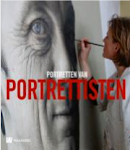This is an article written by art critic Jimenez Abarca on the paintings from the exhibition Bella and Terca and those from my exhibition (Not) Guilty:
The Paint and the Blood
by Juan Carlos Jiménez Abarca The Paint and the Blood
Mir(i)ada
Published at the Suplemento of Letras de Cambio from the newspaper Cambio de Michoacán
(Original in Spanish via Google translate)
 Mask XI (2008), Gustavo Monroy, cover of the magazine Proceso, number 1771, October 2010, Marisa Polin and Slice (2008) oil on canvas, Omar Rodriguez-Graham.
Mask XI (2008), Gustavo Monroy, cover of the magazine Proceso, number 1771, October 2010, Marisa Polin and Slice (2008) oil on canvas, Omar Rodriguez-Graham.Numerous magazines in our country pay attention to the political themes with in- depth journalism articles. Less abundant are the magazines of this type that include articles of art criticism or opinion on areas of culture in its content. But few are those who devote the cover and main article in the publication of the work of a Mexican painter, even though that article has only 5 pages long and many pictures, so that reading is actually a few words to go.
The number 1771 of Proceso magazine, which corresponds to October this year, shows on its cover a pictorial version of the photograph taken of Diego Fernandez de Cevallos by their captors, distributed on 26 September in the national newspapers. The title of the magazine is: Art of Today’s Mexico.
The author is Marisa Polin, a Mexican who has lived 20 years in The Netherlands, and the image corresponds to the series (Not) Guilty, on display at World Art Delft (WAD) in the city of Delft. The exhibition is on display from 12 September until 31 October. In the words of Marco Appel, the Proceso journalist, this is "one of the most provocative exhibitions that have taken place in Holland with Mexican violence as a theme." We have to know how many exhibitions have been made in this country with the Mexican violence as theme to verify that, indeed, if it is the most provocative of all. The reporter's comment could had been left out.
The painting The Boss has as origin the impression caused to Polin by the photograph of Diego Fernandez for a double symbolism: “on the one hand, the representation of a man aged and impotent in front of his tragic situation, and secondly, the arrogant politician and robust than is reflected at the cover of Proceso. It is the image of humiliation." The rest of the works bear the same tone: things that are published in the media and no one wants to see, like a subject bound by hands and feet just thrown from a car, a naked man sitting on a chair with his arms tied to the back, with lost eyes and a slight smile, mysterious, mainly by the letter "Z" carved into his flesh up to the chest: he is dead.
Other are images that are fatefully familiar: virgins and other religious images in the grips of the pistols used by gunmen, a soldier (or two officers) presenting a man, guarding the caught objects: weapons, ammunition, drugs and more.
I must say. It is a plastic proposal, in its economy of line and color contrast, shows an aesthetic vision of something that politically almost nobody wants to be shown abroad Mexico, particularly the federal government and diplomats, including Ambassador Jorge Lomonaco in The Netherlands. He said that there were no newspaper articles about the exhibition and it has gone unnoticed, leaving no impact on the country. But the fact that Polin paintings are going to be exhibited soon in the Gallery Ruimtevaart in The Hague makes you think about the cultural consumption of these images.
In Mexico there are other painters who incorporate social issues and rawness in their work, creating a beautification of violence, acquiring a bewildering emotional quality. Two of them exhibited last July at the Museum of Modern Art (Mexico City) Bella and Terca, nine arguments about painting.
The show could be read as the work of Gustavo Monroy,"involves the use of invoices and compositions, sometimes associated with narrative style of late medieval painting, or sometimes mystical theatrical Baroque religious painting, to exalt the drama and the iconic force of topics from current news of our country.” A Last ‘Mexican’ Supper is a table with tablecloth that brings together twelve bloodied heads without their bodies, Mexico Lindo y Querido shows a national emblem on the decapitated portrait of the painter. He himself suicidally points to his head while carrying a plastic mask of former President Salinas de Gortari in Table XI Mask (2008).
Monroy constructs symbols over the violent reality experienced by our country. In an interview in 2009, commented that given the social reality that he noticed in the present-day -reported reading 3 different newspapers-, could not base his artwork in blowing up balloons and exhibiting them at the museum.
The second artist is Omar Rodriguez-Graham. His case is no less political by his social themes in its work: showing mutilated female bodies located in the morgue. A wall text reads: "In the paintings of Omar Rodriguez-Graham is shown the expression of the paint with a spatula or with masses of pigment, he is working with the construction of forms that are self contained and achieve a large monumental composition with high impact. This tectonic violence of the human forms -bounded by a sophisticated frame- shifts the criminal theme of the work to a non-narrative territory of refined sensuousness." In other words, distance to what otherwise would seem horrible and intolerable; through the beautification of the violent image, the gaze goes to the neck of a young, pale and dead woman and you may continue to watch. What we see is a picture that would show everything with absolute realism, but constructed of colors, shapes, textures and gestural strokes.
"Many people think that my work tries to present or criticize the violence. These people are wrong because it fails to see the painting as more than an image. My work is painting and not image.” The words of Omar Rodriguez about his work resemble those of Marisa Polin talking about her paintings: "It has an aesthetic goal. It is an abstraction of what is happening in Mexico. I am describing a very cruel act. You approach the form with curiosity, it is beautiful, economical on lines. Only in a second or third moment you realize what it is, and you can not deny what you see ... "
The author is Marisa Polin, a Mexican who has lived 20 years in The Netherlands, and the image corresponds to the series (Not) Guilty, on display at World Art Delft (WAD) in the city of Delft. The exhibition is on display from 12 September until 31 October. In the words of Marco Appel, the Proceso journalist, this is "one of the most provocative exhibitions that have taken place in Holland with Mexican violence as a theme." We have to know how many exhibitions have been made in this country with the Mexican violence as theme to verify that, indeed, if it is the most provocative of all. The reporter's comment could had been left out.
The painting The Boss has as origin the impression caused to Polin by the photograph of Diego Fernandez for a double symbolism: “on the one hand, the representation of a man aged and impotent in front of his tragic situation, and secondly, the arrogant politician and robust than is reflected at the cover of Proceso. It is the image of humiliation." The rest of the works bear the same tone: things that are published in the media and no one wants to see, like a subject bound by hands and feet just thrown from a car, a naked man sitting on a chair with his arms tied to the back, with lost eyes and a slight smile, mysterious, mainly by the letter "Z" carved into his flesh up to the chest: he is dead.
Other are images that are fatefully familiar: virgins and other religious images in the grips of the pistols used by gunmen, a soldier (or two officers) presenting a man, guarding the caught objects: weapons, ammunition, drugs and more.
I must say. It is a plastic proposal, in its economy of line and color contrast, shows an aesthetic vision of something that politically almost nobody wants to be shown abroad Mexico, particularly the federal government and diplomats, including Ambassador Jorge Lomonaco in The Netherlands. He said that there were no newspaper articles about the exhibition and it has gone unnoticed, leaving no impact on the country. But the fact that Polin paintings are going to be exhibited soon in the Gallery Ruimtevaart in The Hague makes you think about the cultural consumption of these images.
In Mexico there are other painters who incorporate social issues and rawness in their work, creating a beautification of violence, acquiring a bewildering emotional quality. Two of them exhibited last July at the Museum of Modern Art (Mexico City) Bella and Terca, nine arguments about painting.
The show could be read as the work of Gustavo Monroy,"involves the use of invoices and compositions, sometimes associated with narrative style of late medieval painting, or sometimes mystical theatrical Baroque religious painting, to exalt the drama and the iconic force of topics from current news of our country.” A Last ‘Mexican’ Supper is a table with tablecloth that brings together twelve bloodied heads without their bodies, Mexico Lindo y Querido shows a national emblem on the decapitated portrait of the painter. He himself suicidally points to his head while carrying a plastic mask of former President Salinas de Gortari in Table XI Mask (2008).
Monroy constructs symbols over the violent reality experienced by our country. In an interview in 2009, commented that given the social reality that he noticed in the present-day -reported reading 3 different newspapers-, could not base his artwork in blowing up balloons and exhibiting them at the museum.
The second artist is Omar Rodriguez-Graham. His case is no less political by his social themes in its work: showing mutilated female bodies located in the morgue. A wall text reads: "In the paintings of Omar Rodriguez-Graham is shown the expression of the paint with a spatula or with masses of pigment, he is working with the construction of forms that are self contained and achieve a large monumental composition with high impact. This tectonic violence of the human forms -bounded by a sophisticated frame- shifts the criminal theme of the work to a non-narrative territory of refined sensuousness." In other words, distance to what otherwise would seem horrible and intolerable; through the beautification of the violent image, the gaze goes to the neck of a young, pale and dead woman and you may continue to watch. What we see is a picture that would show everything with absolute realism, but constructed of colors, shapes, textures and gestural strokes.
"Many people think that my work tries to present or criticize the violence. These people are wrong because it fails to see the painting as more than an image. My work is painting and not image.” The words of Omar Rodriguez about his work resemble those of Marisa Polin talking about her paintings: "It has an aesthetic goal. It is an abstraction of what is happening in Mexico. I am describing a very cruel act. You approach the form with curiosity, it is beautiful, economical on lines. Only in a second or third moment you realize what it is, and you can not deny what you see ... "
The original text at newspaper Cambio de Michoacán
More texts from the press.

ada.jpg)



















No comments:
Post a Comment